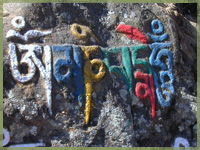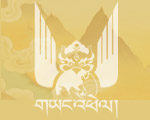 Kyichu
Lhakhang in Paro and Jampe Lhakhang in Bumthang are two of Bhutan's
most important religious sites, symbols of Buddhism's arrival.
Tradition records that these temples were part of a greater
scheme chosen by the seventh century Tibetan King Songtsen Gampo
to tame a huge demoness extending over the whole land, creating
numerous obstacles to the spread of Buddhism. He is said to
have magically multiplied himself, sending his emanations to
build 108 temples in one day on each of her joints, thus pinning
her down and immobilizing her. Of these, 13 were the most important:
the Lhasa Jokhang was constructed on the heart of the demoness;
four temples, "the four great horn suppressors", were
built in central Tibet; four temples, "the temples to tame
the border", were built farther away, of which Jampe Lhakhang
is on the left knee of the demoness; finally four more temples,
"the temples to tame the area beyond the border",
were built on the extremities of the Tibetan sphere of influence,
of which Kyichu Lhakhang is on the left sole of the demoness. Kyichu
Lhakhang in Paro and Jampe Lhakhang in Bumthang are two of Bhutan's
most important religious sites, symbols of Buddhism's arrival.
Tradition records that these temples were part of a greater
scheme chosen by the seventh century Tibetan King Songtsen Gampo
to tame a huge demoness extending over the whole land, creating
numerous obstacles to the spread of Buddhism. He is said to
have magically multiplied himself, sending his emanations to
build 108 temples in one day on each of her joints, thus pinning
her down and immobilizing her. Of these, 13 were the most important:
the Lhasa Jokhang was constructed on the heart of the demoness;
four temples, "the four great horn suppressors", were
built in central Tibet; four temples, "the temples to tame
the border", were built farther away, of which Jampe Lhakhang
is on the left knee of the demoness; finally four more temples,
"the temples to tame the area beyond the border",
were built on the extremities of the Tibetan sphere of influence,
of which Kyichu Lhakhang is on the left sole of the demoness.
The founding father and preeminent figure in Bhutanese Buddhism
was Padmasambhava - Guru Rinpoche, "the precious master".
The major growth of Buddhism in Bhutan began with his arrival
in the eighth century. Born in the Swat province of what is
now Pakistan, he became a Buddhist tantric master and brought
numerous teachings to Tibet and throughout the Himalayan Buddhist
world. His wisdom laid the firm foundation for Buddhism's
spread in Bhutan, where he traveled fairly extensively, left
countless stories about his subduing of local demons and deities,
and was the founding inspiration for many sacred sites, notably
Taktsang Lhakhang in Paro and Kurje Lhakhang in Bumthang.
Guru Rinpoche is widely revered as the second Buddha, and
his followers, later known as Nyingmapas, "the ancients",
constituted the first Buddhist school in Tibet.
Following this initial impetus, Buddhist belief steadily spread
throughout the land achieving a degree of hegemony. The ninth
and tenth centuries were a period of political turmoil in
Tibet, and marked the almost total disappearance of Buddhism
in the region. It was only in the eleventh century that there
was a renaissance, and what is called "the period of
the second diffusion of Buddhism" commenced. Numerous
competing schools arrived in Bhutan, founding monasteries,
gathering followers and gaining both spiritual and temporal
authority in respective parts of the country. Of these, the
Drukpa Kapyupas and the Nyingmapas were to achieve some ascendancy.
The Drukpa Kagyupa School was introduced to Bhutan by Phajo
Drukgom Shingpo (1184-1251), who was instrumental in achieving
initial dominance in the west, and whose descendants solidified
both spiritual and temporal power. The Nyingmapa School had
been present in Bhutan since the time of Guru Rinpoche, and
gradually widened their sphere of influence in the central
and eastern regions through a series of significant figures
and an emerging religious nobility descended from the families
of important saints.
The period up to the seventeenth century was a time of Buddhist
dissemination, as Bhutan became a sanctuary for the "three
jewels" - the Buddha, the Dharma (his teachings) and
the Sangha (his followers). This was epitomized by the presence
of figures possessing the power to inspire both local leaders
and the popular masses. Longchen Rabjampa (1308-1363), the
greatest Nyingmapa philosopher, chose exile in central Bhutan
following a dispute with his Tibetan master. Dorje Lingpa
(1346-1405), one of the foremost Tibetan tertons or treasure
revealers, settled in Bumthang. However, the figures that
are most recalled are probably Drukpa Kunle (1455-1529) and
Pema Lingpa (1450-1521). Drukpa Kunle, the "divine madman",
is a Bhutanese folk hero, famous for the unorthodox and often
outrageous ways in which he taught religion. Wandering through
Tibet and Bhutan as a yogi, his style of teaching, particularly
accessible to the common man, was a reaction against the dogmatism
of the clergy and rigid social conventions, which he saw as
being impediments to the grasping of the true meaning of the
religion. He remains the subject of a host of anecdotes in
which sex plays a defining role. Pema Lingpa, born in Bumthang
of noble Nyingmapa birth, was the first Bhutanese-born religious
figure to gain significant fame throughout the Tibetan Buddhist
world. In a vision of Guru Rinpoche he attained prophecies
for the discovery of a number of hidden teachings, thus becoming
a great terton.
|



